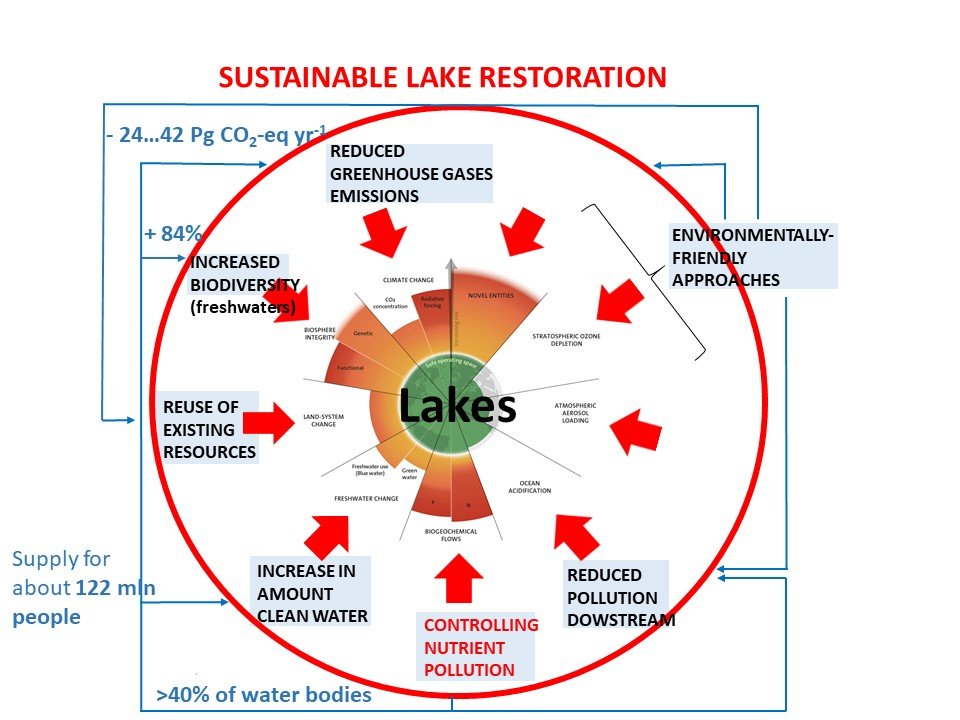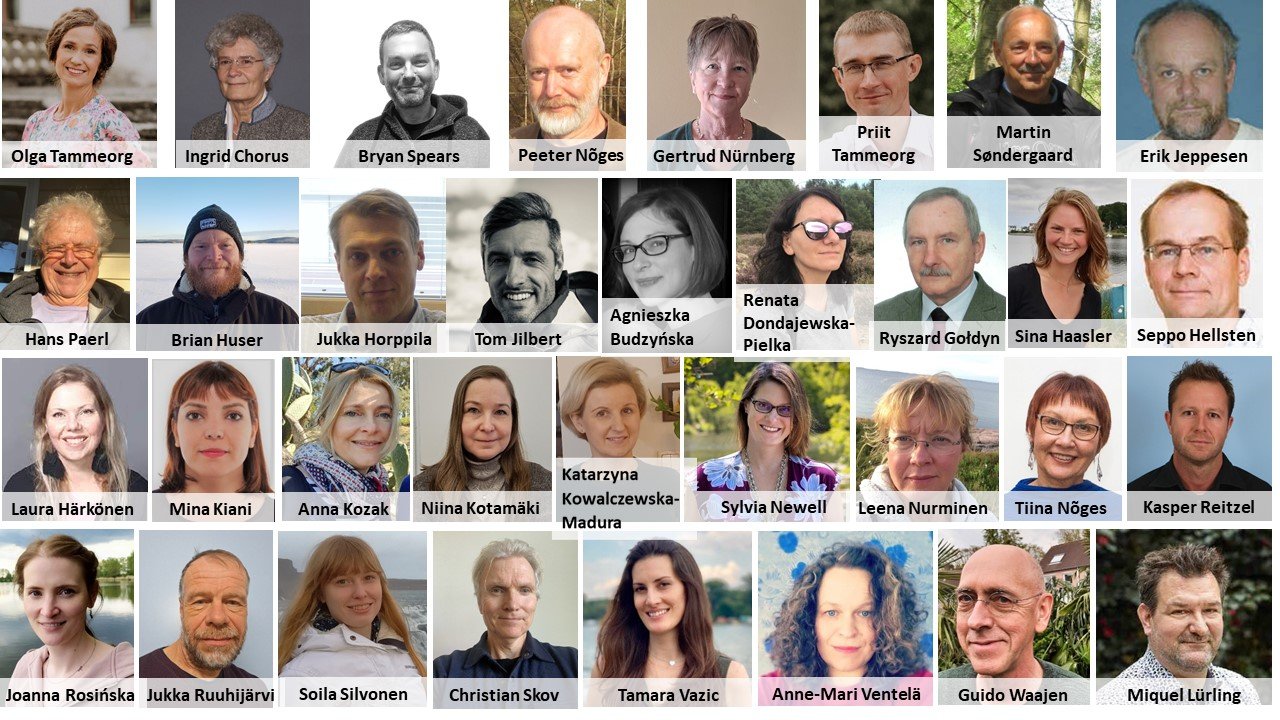We have fantastic news to share: our groundbreaking research on sustainable lake restoration, including recycling of lake sediments to agriculture, has just been crowned National Champion of Finland by the prestigious Frontiers Planet Prize! 🌍✨🏆
Our pioneering work introduces a groundbreaking strategy designed to steer our planet back into a safe operational zone, tackling nutrient pollution in our precious lakes head-on. By harnessing cutting-edge, eco-friendly methods that emphasize nutrient recycling, we're not only combating eutrophication but simultaneously striking at the heart of interconnected environmental issues - from curtailing greenhouse gas emissions to preserving biodiversity.
This recognition propels us into the ranks of the 23 National Champions, shining a global spotlight on our efforts in the Planetary Boundaries sustainability science competition.
Lakes, ensuring food security, the provision of clean water for drinking and irrigation, recreation and biodiversity, have been centers for human life and activities for ages. The provision of these services is, however, dependent on the extent of the water pollution by major nutrients, nitrogen and phosphorus, i.e. eutrophication.
Eutrophication remains a main cause of water quality impairment in lakes globally. It is commonly recognized by unsightly and smelly scums of the blue-green algae (cyanobacteria) on the lake surfaces. These scums can be very toxic (known as harmful algal blooms), causing human health risks and compromising water use for drinking and irrigation. For example, drinking water crisis in Toledo on western Lake Erie (USA) in August 2014 interrupted water supply for about 0.5M people due to the high level of cyanobacterial toxins in finished water. Drinking water crisis in Wuxi (China) in 2007 affected about 4M people. Moreover, degrading blooms lead to oxygen depletion, siltation, massive fish mortality. Further economic losses are caused by high emissions of greenhouse gases (especially, methane) from eutrophic lakes. Over 40% of the world’s lakes (UN, 2021) are impacted. Yet, this value is underestimated, given that water quality remains unmonitored in regions with untreated wastewater. Also, freshwaters have the highest rate of biodiversity decline of all ecosystems. Thus, eutrophication leads to compromised ecosystem service delivery locally and affects economies and social stability globally.
The extent of eutrophication is projected to double in response to climate change and population growth, leading to methane emissions from lakes and reservoirs more than 50% of current fossil fuel emissions. The substantial accumulation of nutrients in watersheds (legacy nutrients) will continue to damage ecological health in lakes for decades to come if left unmanaged. These challenges trigger a need for drastic changes in the existing approaches to eutrophication management.
Sustainable lake restoration is our overarching solution to eutrophication, aiming to improve ecological state while delivering a number of other environmental and socio-economic co-benefits extending beyond the scale of intervention. We are developing numerous tools based on decades of expertise in lake restoration science, in order to reach a synergetic solution that is effective both environmentally and economically and crucially, that supports nutrient recycling, reuse and recovery (circular economy). For example, sediment removal from lakes may decrease nutrient concentrations and cyanobacterial blooms, leading to reduced greenhouse gases emissions, increased amenity and recreation value. At the same time, the sediment removed can be used as a fertilizer, improving situation with non-renewable phosphorus rock (P rock) availability and prices. Very narrow circle of countries control economically reasonably exploitable P stocks, namely Morocco, USA and China, with the latter two having already minimalized the exports. The P rock stocks controlled by Morocco tend to have higher content of cadmium and other heavy metals, but are also affected by the political instability around P-rich Western Sahara (the sole African colony according to UN). The situation with P rock availability and price has only worsened since 2022 with the Russian military aggression on Ukraine and the following sanctions to Russia and Belarus to the point where food security becomes jeopardized globally.
Each lake should be assessed individually to ensure best solution to the lake-specific problems. In general, we promote combined approaches including reduced nutrient inflow from catchments as well as in-lake measures (addressing nutrient release from sediments). We develop and enhance tools enabling to quantify the impacts of different interventions on lake nutrient concentrations, to establish linkage with the potential environmental and socio-economic benefits.
The overarching solution we propose is global in scale, but delivered through a network of local-scale actors. For example, reduction of emissions of greenhouse gases in thousands of individual lakes directly impacts local communities and stakeholders in each case (improved lake ecosystem health), but also contributes directly to carbon cycling on the global scale (reduced emission of greenhouse gases). Individual stories of restoration success at local scale act as beacons and can be communicated regionally and internationally as a showcase for tailoring site-specific solutions. Civil society is not a passive observer in sustainable lake restoration, but rather is actively involved in developing, implementing and benefiting from its solutions. This is an important aspect of the new-generation water quality management strategy. We underline that achieving optimal, sustainable results from lake restoration relies on multidisciplinary research and close interactions between environmental, social, political, and economic sectors. In 2023, the outcomes of our paper were included in a White Paper on Embedding Lakes into the Global Sustainability Agenda to raise awareness on the benefits of sustainable lake management to the global restoration community. This White Paper was launched by the United Nations Environment Programme at the UN Water Conference, New York, 2023 and is being used to inform the implementation of a United Nations Environment Assembly Resolution 5/4 on Sustainable Lake Management (UNEP/EA.5/Res.4), reaching all UN member states. We now work through our international partnership to enable transformative change in this field. Our solution will support Target 2 of the Biodiversity Plan For Life on Earth aiming at restoring 30% of all Degraded Ecosystems by 2030.
By advocating sustainable nutrient management, we are delivering directly to the Planetary Boundaries science (Fig. 1). Lakes is the key model system to demonstrate this approach because nitrogen and phosphorus flows have already transgressed their planetary boundary, lakes are significant source of greenhouse gases emissions and regulate climate, and freshwater has highest rate of biodiversity loss. This is in line with the results of the update on the framework of the Planetary boundaries in 2023 indicating that six of nine boundaries are transgressed and pressure is increasing. Our research helps to design and implement restorative measures for lake ecosystems beyond the control of nutrients and ecological responses, thus, supporting understanding of the interplay between the boundaries. These include sustainability- and use-based benefits (e.g., net zero carbon and socio-economic gains such as food security via sustainable fertilizers), supporting international policy initiatives (e.g., the UN Sustainable Development Goals (SDGs) & Decade on Restoration; European Green Deal & Biodiversity Strategy 2030) that aim to keep the planet within its boundaries. Our research contributes to the understanding of the relationships between ecological processes and wider sustainability indicators, and better integration of circular economy approaches into freshwater management via addressing major knowledge gaps.
 Figure 1. Sustainable lake restoration enables to bring the Planet back to the safe operation space. By controlling nutrient pollution to lakes effectively and with the use of environmentally friendly approaches that support nutrient recycling, reuse and recovery, we address a number of interlinked environmental problems.
Figure 1. Sustainable lake restoration enables to bring the Planet back to the safe operation space. By controlling nutrient pollution to lakes effectively and with the use of environmentally friendly approaches that support nutrient recycling, reuse and recovery, we address a number of interlinked environmental problems. Photo 1. Our team exploring sustainable lake restoration and delivering to the planetary boundaries science.
Photo 1. Our team exploring sustainable lake restoration and delivering to the planetary boundaries science.